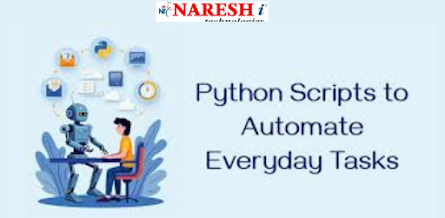Automating Everyday Tasks with Python Scripts
In the fast-paced digital world, time is a precious resource. Whether you’re a working professional, student, or entrepreneur, finding ways to streamline daily activities can make a big difference. This is where Python, a versatile and beginner-friendly programming language, shines—especially when paired with practical training like a Full Stack Python Training program. Automating routine tasks not only saves time but also boosts productivity and accuracy.
Why Use Python for Automation?
Python is known for its clean syntax and vast library support. From sending emails and renaming files to scraping web data and automating spreadsheets, Python makes it easy for anyone to automate repetitive tasks. It’s not just about knowing the language—it’s about learning how to apply it effectively. That’s why many developers turn to structured learning paths such as Full Stack Python Training, which covers front-end, back-end, and automation skills all in one curriculum.
Everyday Tasks You Can Automate with Python
Here are some common daily tasks you can automate using simple Python scripts:
1. Email Automation
You can use Python's smtplib and email libraries to send scheduled emails or newsletters. For businesses, this can streamline customer communication and internal updates.
2. Web Scraping for Information
Python’s BeautifulSoup and requests libraries allow you to extract information from websites. Whether you're tracking product prices or collecting data for research, scraping automates hours of manual work.
3. File and Folder Organization
Use Python to rename, move, or organize files based on naming conventions or file types. This is especially helpful for photographers, designers, and content creators.
4. Excel and Google Sheets Automation
With openpyxl, pandas, or gspread, Python can read and update spreadsheets automatically, making data analysis and report generation seamless.
5. Social Media Posting
Python can interact with APIs like Twitter, Facebook, or Instagram to automate posting content or fetching updates, saving marketers a lot of manual effort.
Learning to Automate: The Role of Full Stack Python Training
Learning how to automate tasks effectively isn’t just about knowing a few lines of code. It's about understanding how to build complete, scalable solutions that can integrate with web services, databases, and user interfaces.
A good Full Stack Python Training program doesn’t just teach you Python basics—it dives deep into frameworks like Django or Flask, front-end technologies like HTML, CSS, and JavaScript, and even DevOps tools. This holistic knowledge enables you to automate tasks within full-scale applications, not just on your local machine.
For example, instead of just writing a script to email a report, you could build a web dashboard that collects user data, analyzes it in real time, and emails insights at scheduled intervals—all built using your full stack skills.
Real-World Applications
-
Finance: Automate invoice generation and transaction tracking.
-
Education: Automatically grade quizzes and manage student data.
-
Healthcare: Process patient records and send reminders.
-
Retail: Monitor inventory levels and automate reorder processes.
These are just a few examples of how automation powered by Python is transforming industries.
Conclusion
Automating everyday tasks with Python scripts isn't just a tech trick—it's a game-changer for personal and professional efficiency. By investing in Full Stack Python Training, you not only learn how to write scripts, but also how to deploy them as part of larger, scalable systems. Whether you're looking to boost productivity at work, save time at home, or build a side project, automation is a skill that pays off quickly—and Python is your best starting point.
.png)


.png)
Comments
Post a Comment